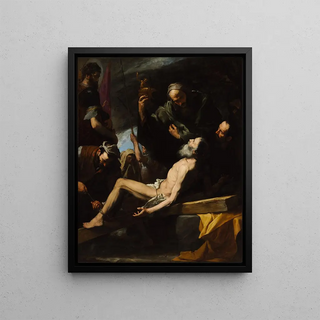Art print | Martyrdom of Saint Andrew - Jusepe de Ribera Source: Reproduction | Martyre de saint André - Jusepe de Ribera


View from behind

Frame (optional)
In the fascinating world of baroque art, the art print "Martyre de saint André" by Jusepe de Ribera stands out for its emotional power and dramatic intensity. This canvas, depicting the Christian martyr enduring atrocious suffering, invites us to reflect on faith and sacrifice. The choice of subject, a saint whose life was marked by pain and persecution, resonates deeply with the spiritual values of the time. Through this art print, the artist manages to capture not only the battered body of saint André but also the tormented soul of the martyr, offering a poignant vision of the human condition.
Style and uniqueness of the work
Ribera's technique, characterized by striking chiaroscuro, gives this art print an atmosphere that is both oppressive and captivating. The play of light and shadow accentuates the features of saint André's face, revealing an expression of pain mixed with unsettling serenity. The color palette, with dark and earthy tones, evokes a brutal reality that contrasts with the spirituality of the subject. Every detail, from the emaciated body to the heavy drapery, demonstrates technical mastery and artistic sensitivity that make Ribera an undisputed master of his time. This painting, far from being a simple representation, becomes a true sensory experience, inviting us to feel the suffering of the saint and to reflect on universal themes of faith and resilience.
The artist and his influence
Jusepe de Ribera, born in Spain and active in Italy, is often associated with the Neapolitan school, where he developed a unique style that combines Caravaggio's influences with Spanish sensibility. His work is marked by a deep interest in the human condition, explored through religious and secular subjects. Ribera transcended the conventions of his era by offering a more realistic and emotional vision of holy figures. His impact on baroque art is undeniable, inspiring many artists both in Europe and beyond. The way he handles light and texture, as well as his psychological approach to characters, continues

Matte finish

View from behind

Frame (optional)
In the fascinating world of baroque art, the art print "Martyre de saint André" by Jusepe de Ribera stands out for its emotional power and dramatic intensity. This canvas, depicting the Christian martyr enduring atrocious suffering, invites us to reflect on faith and sacrifice. The choice of subject, a saint whose life was marked by pain and persecution, resonates deeply with the spiritual values of the time. Through this art print, the artist manages to capture not only the battered body of saint André but also the tormented soul of the martyr, offering a poignant vision of the human condition.
Style and uniqueness of the work
Ribera's technique, characterized by striking chiaroscuro, gives this art print an atmosphere that is both oppressive and captivating. The play of light and shadow accentuates the features of saint André's face, revealing an expression of pain mixed with unsettling serenity. The color palette, with dark and earthy tones, evokes a brutal reality that contrasts with the spirituality of the subject. Every detail, from the emaciated body to the heavy drapery, demonstrates technical mastery and artistic sensitivity that make Ribera an undisputed master of his time. This painting, far from being a simple representation, becomes a true sensory experience, inviting us to feel the suffering of the saint and to reflect on universal themes of faith and resilience.
The artist and his influence
Jusepe de Ribera, born in Spain and active in Italy, is often associated with the Neapolitan school, where he developed a unique style that combines Caravaggio's influences with Spanish sensibility. His work is marked by a deep interest in the human condition, explored through religious and secular subjects. Ribera transcended the conventions of his era by offering a more realistic and emotional vision of holy figures. His impact on baroque art is undeniable, inspiring many artists both in Europe and beyond. The way he handles light and texture, as well as his psychological approach to characters, continues






